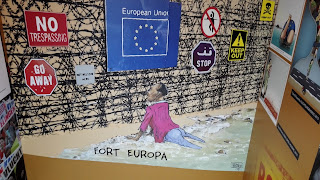A visit to a residence in exile, Huis Doorn. Fascinating.
And what, you may ask, is Huis Doorn? Good question. It is a place of historical significance, and one that we knew very little about, until our visit.
Huis Doorn was once the residence in exile of the last German Emporer, Wilhelm II. It all started at the end of WW1 when the defeat suffered by Germany was widely seen as Willem II's personal failure. The republic was proclaimed on November 8th, 1918, while the Emporer was in his headquarters in the Belgian city of Spa. He knew he could not return to Germany, so set off to the neutral Netherlands. Luckily for the Emporer, the Dutch government granted him permission to take up residence in their country. Wilhelm consequentially signed his abdication.
The German Government provided money to purchase a country estate, and to transport some furniture and personal effects from Wilhelm's palaces in Potsdam and Berlin. The German Government also provided enough money for him to live in relative luxury, although he was only allowed to travel 15 km from his home. During the depression, the funds from Germany were greatly reduced, which meant the Emporer had fewer servants. He still lived very well.
The Emporer lived at Doorn until he died in 1941. His first wife, Auguste Viktoria, died in 1921, and he then married Hermine, the widow of Prince Johann Georg Schoenaich-Carolath. When the Emporer died, his family were told that they would have to start paying taxes, which they could not afford, so the Huis Doorn became a museum. Hermine went back to her family home in Poland, which was fine until the Russians took over in 1945. She was not allowed to live in luxury and was sent to Frankfurt to live in a two bedroom flat. A bit of a come down. She died a few years later.
A fascinating history lesson.
Walter posing in front of the gate house, which was built in order to provide security and privacy for the Emporer.
A beautiful path between the tall trees.
Huis Doorn, set in beautiful grounds.We had a tour of the house, furnished beautifully and magnificantly. Unfortunately I was too busy trying to listen to, and understand, the Dutch explanations to take photographs.
A very large turtle lives in the pond, which Raphy saw, when he visited the house with Aaron and Kylie. We looked, but did not catch sight of the turtle.
But back to Wilhelm II. He spent his days walking around the estate, chopping wood, and reading books about theology and archeology. He insisted on discussing the information gained from his reading, with family and guests. This must have been very boring unless you were interested in theology and archeology. Wilhelm also had one arm that was shorter than the other, which made the chopping of wood quite difficult. He also had a special spoon to help him eat food.
The last piece of information. Willem II was the grandson of Queen Victoria, the British queen, and the son of her eldest daughter, also called Victoria. A very German family.
One of the other buildings is now the restaurant, and cafe, where we sat on the patio and drank a delicious cup of coffee.
There was a temporary exhibition in the huge garage about WW1. It also focussed on the plight of the people who fled into the Netherlands from Belguim during the war.
The country could not cater for the large numbers of refugees, and finally had to build fences between the two countries to stop the increasing numbers from entering the country.
The display compared the plight of the people from Belguim during WW1 with the refugees that are currently trying to enter the European Union. It was a very poignant display.
A final note. The visit also made us think about the events that occurred after Germany became a republic. And how history may have been completely different had Germany experienced victory in 1918. Emporer Wilhelm II would not have abdicated, and Hitler would not have become a powerful leader. And there may not have been a WWII as most of Europe may have been under German rule anyway.
All very fascinating.








No comments:
Post a Comment